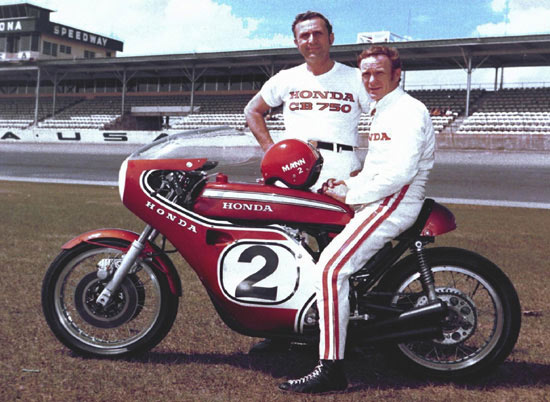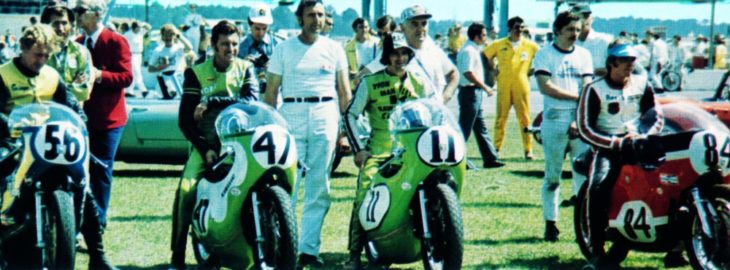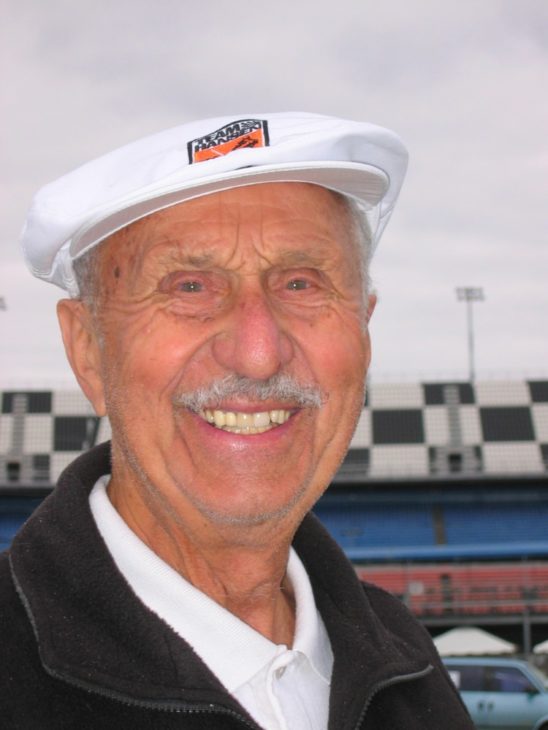Larry Lawrence | October 23, 2018
Archives: The Man Who Helped Get Honda Racing in America
Honda was selling motorcycles like hotcakes in the 1960s. The Japanese maker redefined motorcycling in this country and its reliable little machines won over a generation of new motorcyclists. That group would serve as backbone for a massive expansion of motorcycle sales during the 1970s and onward. One thing Honda didn’t do much in those early days was race, at least not here in America. Enter Bob Hansen. Hansen was a former racer turned Honda dealer and he saw serious racing potential in some of Honda’s quietly quick street bikes and began converting some of them into racing machines. Hansen’s success gradually got Honda’s attention and when the company decided to race its revolutionary CB750, at Daytona in 1970, it was Hansen they turned to.
Archives: The Man Who Helped Get Honda Racing in America
 Bob Hansen with rider Dick Mann at the 1970 Daytona 200.
Bob Hansen with rider Dick Mann at the 1970 Daytona 200.
Born in Racine, Wisconsin, on Oct. 15, 1919, Hansen first became interested in motorcycles when he was in high school. A school buddy was a motorcyclist and Hansen decided he wanted to try the sport as well. At 16, and with little money, his solution was to buy a 1931 74-cubic-inch Harley-Davidson totally disassembled in a bushel basket. Hansen and his buddy never quite completed the restoration of the old Harley, but they got close enough that Hansen was able to work out a deal with the Racine Harley-Davidson dealer to trade in the partially completed bike on a newer 45-cubic-inch model. At times, his motorcycle was his only form of transportation and Hansen rode year-round, even in the brutal Wisconsin winters, by mounting a sidecar on his Harley.
Hansen joined the local motorcycle club and became quite involved in the club’s activities. One of the primary activities was racing. By the time he was 18 years old, Hansen was competing in just about every form of motorcycle racing, from hillclimbing to TT and flat track races.
“Those were the true early days of Class C racing,” Hansen explained. “We would ride our motorcycles to the races, strip them down for the race, then put them back together afterwards and ride them home.”
After serving in World War II, Hansen resumed racing and earned a national number. He raced mainly in the Midwest, but occasionally ventured farther, such as the annual trek to Daytona every spring.
By the late 1950s, Hansen was tuning for and sponsoring several racers primarily on BSAs. In 1960, Hansen opened a motorcycle dealership in Racine and was one of the first dealers in the Midwest to sell Honda motorcycles. Hansen was soon asked to set up a regional parts warehouse, which he did in Racine. For a time, he was in charge of setting up many of the earliest Honda dealerships in the Midwest. Still in love with racing, Hansen, without Honda’s knowledge, built a few Hondas that were successfully raced in Canada as early as 1962. Honda brass politely asked him to quit building the race bikes when customers began calling Honda to get these “racing models” for themselves. He continued to move up the ladder at Honda and eventually moved to the company’s headquarters in Southern California to head up the service department.
While with Honda, Hansen headed up several racing efforts with the company’s lightweight and middleweight motorcycles. Most notable was a semi-factory Honda effort at Daytona in 1967 with a trio of HRC-prepared CB450s.
When Honda introduced its revolutionary CB750, it wanted to prove the speed and reliability of the new machine by racing in the 1970 Daytona 200. Hansen was given the responsibility of heading up the effort on the American side. Hansen recalls that the CB750s (of which there were four factory entries) had plenty of speed, but there was a problem with the cam-chain tensioner on the high-speed Daytona circuit. After the problem was discovered, Hansen made the decision to keep Mann off the bike during the final day of practice so that the machine could be totally rebuilt. Mann’s bike was the only factory Honda to go the distance and he won the race over the Triumphs of Gene Romero and Don Castro, despite Mann’s Honda having less than a half-quart of oil left in the engine at the finish.
It marked the first win in the Daytona 200 by a Japanese manufacturer.
“You have to give a lot of the credit to Bob,” said Dick Mann on his 1970 Daytona victory. “He did some extra work on the bike that the European teammates didn’t do, and our bike finished and they didn’t. We had a good strategy and worked well together, and it was a real workout for both of us, but it all worked out at the end.”
Just a few months after Honda’s victory at Daytona, Hansen accepted an attractive offer to work for Kawasaki. That company wanted to establish a name in racing as well and felt Hansen would be the right person to coordinate its efforts. It proved to be a good decision. Under Hansen’s guidance, Kawasaki won its first AMA national with Yvon DuHamel, and became a powerhouse in U.S. racing.
 Hansen (white t-shirt) headed up Kawasaki’s racing effort in 1971.
Hansen (white t-shirt) headed up Kawasaki’s racing effort in 1971.
While at Kawasaki, Hansen also served as vice president of the AMA’s competition committee, the rules-making body for racing. Hansen was also the U.S. delegate on the F.I.M. road racing committee.
By the mid-1970s, Hansen had moved out of the motorcycle industry. After a short stint with the Italian manufacturer, Laverda, Hansen made his living in real estate.
 Bob Hansen in 2004.
Bob Hansen in 2004.
After retiring Hansen kept up with his interest in motorcycles by restoring collector bikes and acting as a consultant for Heritage Racing, Honda’s vintage racing division. He was also in demand at various racing gatherings and gave talks on his days in racing.
Hansen died Feb. 17, 2013. He was 93.
Hansen will always be remembered for many things, but perhaps most notably for helping Honda see the wisdom of getting more heavily involved in American racing during a period of explosive growth in the sport.